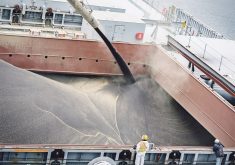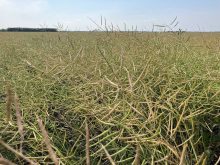Chinese market | China will be the top buyer for a big Canadian crop
With Western Canada’s canola crop looking strong, analysts hope that China will buy large quantities of it.
That should be safe to assume because Chinese canola stocks are low and its present canola acreage modest. However, Chinese numbers are uncertain and often are manipulated, making it hard for supply and demand fundamentals to be applied, analysts say.
“Just because stocks are depleting doesn’t mean they are going to be actively buying,” said analyst Greg Kostal.
Low Chinese canola stocks “increases the probability of them buying, but the focus will be on margins.”
Read Also

Biofuel sector happy with federal budget
Advanced Biofuels Canada says new Biofuel Production Incentive is a lifeline until CFR amendments are in place.
China has become a major buyer of Canadian canola in recent years and is the leading buyer this year, taking 2.393 million tonnes to the end of April, up from 2.017 million at the same time the year before.
Its demand is becoming key to clearing a Canadian crop that has expanded over the years.
Agriculture Canada this spring estimated canola production at 14.1 million tonnes, but farmers seeded more than expected and weather has generally been good so that number could climb.
China is a significant producer of canola and rapeseed — crops that are used interchangeably in China — but its production generally falls short of its needs.
That deficit is getting more pronounced, U.S. Department of Agriculture estimates suggest, with a steady decrease in Chinese canola stocks.
USDA believes that the Chinese canola and rapeseed stockpile fell from 822,000 tonnes in 2011-12 to 272,000 tonnes in 2012-13 and will dwindle to only 132,000 tonnes at the end of 2013-14.
Normally, falling stocks combined with strong consumption would suggest a sure market for Canadian canola.
But Kostal said the Chinese government deliberately manipulates domestic crop prices and food prices, adjusting stocks up or down to achieve certain policy objectives. So low stocks alone don’t mean they will automatically buy at a steady rate during the year.
Ken Ball of PI Financial said Chinese government manipulation always makes it dangerous to guess when the country will enter world markets.
But one aspect of the manipulation that helps canola is the Chinese government policy of promote the growing of cereal grains as opposed to oilseeds. That means the government is willing to import crops like canola whenever it needs.
“They can’t fill everything (with domestic production),” said Ball.
“They need to import some crops, and it’s obvious they’ve decided to grow ample wheat crops and ample corn crops and short themselves on the oilseed crops.”
That’s why Chinese soybean acreage is stagnant, even though Chinese soybean consumption and imports are booming.
“That’s no accident. China’s still got a centrally-planned economy,” said Ball.
Kostal said China’s manipulation of markets extends to disguising the true state of stockpiles, so even though USDA does its best to peg the true situation, everyone knows it’s just a rough guess.
“We all look at those numbers and put them into our spreadsheets, but the confidence in those numbers is low,” said Kostal.
“There’s what the USDA says and what everyone else believes. These are state secrets.”
Influential oilseed analyst Oil World last week estimated China’s oilseed production at 48 million tonnes this year, down two million from the year before.
Oil World said China’s rapeseed/canola crop would total 11.5 million tonnes. USDA’s forecast is 13 million tonnes.
















